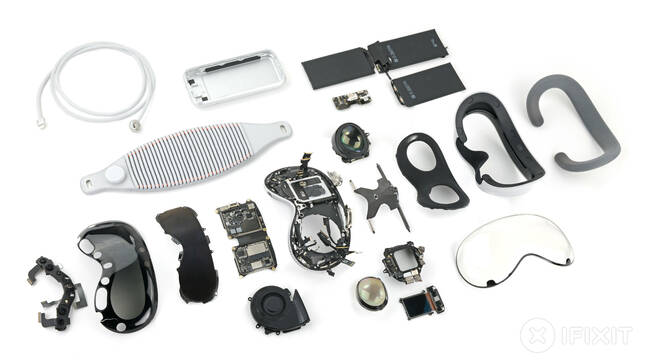IFixit Tears Apple's Vision Pro To Pieces
Tech repair champ iFixit has disassembled Apple's newly released Vision Pro headset and came up with an explanation for why the EyeSight display looks so weird.
Depending on your stance, Apple's VR/AR goggles are either revolutionary or a very visible way of demonstrating that you have $3,499 or so to burn.
iFixit has yet to assign a repairability score to the Vision Pro, however, seeing as the gang managed to break the device in the process of getting into the visor, we're not expecting much. Then again, Apple's approach to shaving weight off by having the user carry the battery in a pocket received a nod from the teardown team.
The battery pack is hefty, consisting of three iPhone-sized batteries that combine to pump out an impressive 35.9 Wh, more than double the 17.3 Wh of the iPhone 15 Pro. Getting into the box, which weighs 353 grams, required softening some glue, releasing some metal clips, and twiddling Torx screws. A relatively simple process when compared to the headset itself.
Next to competitors like the Meta Quest Pro, the Vision Pro is light, although approximately the same weight as Meta's device when the battery is removed. Batteries included, the Vision Pro nudges the kilogram mark, making Apple's decision to have the user carry the battery separately a sensible move.
iFixit was delighted to note the modular nature of the headset. The speakers can easily be removed, although it is best not to try and get into the device. iFixit found them almost as difficult to get into as a pair of AirPods Pro. The light seals are attached with magnets – another logical move considering the variety of face shapes out there.
However, the iFixit team described the connection to the battery as "unforgivable." A magnetic one for the connection to the headset makes sense, but selecting a proprietary connector for the battery pack itself? USB-C would have been the more logical choice, but it seems that old habits die hard at Apple.
Still, if you're prepared to drop that much money on a VR headset, we doubt Apple's approach to cable pricing will cause you to lose too much sleep.
- Apple's easiest to replace battery is in... an iMac
- Google Pixel gets privacy mode to keep your selfies safe from prying repair techs
- Fairphone 5 scores a perfect 10 from iFixit for repairability
- Right-to-repair fight going national as FTC asked to lay down the law
What could haunt your dreams though is the odd-looking display of the wearer's eyes on the front of the device. In theory, it's a neat idea. However, it is marred by some awful execution and, judging by reviews, has proven to be the most controversial part of the headset.
Apple was going for a 3D representation of the upper portion of the wearer's face. The problem is that the display is rather dim and has a low resolution. The iFixit team prised the visor apart – unsurprisingly, the glass is glued on, and the removal process caused some damage – and found lenticular lenses beneath an exterior OLED panel. A 3D face is created via a stereoscopic effect – multiple face images for multiple angles. It all goes together to create the dim and strange face effect.
The EyeSight display is a curious choice in what is otherwise an impressive technical tour de force. The Vision Pro packs an M2 chip, alongside some dedicated AR silicon, into something that can be worn on the face. While the iFixit team noted that repairability was "not great" – that glass looks awfully fragile – there were some thoughtful touches. However, the hardware pairing required for prescription insert lenses came in for criticism.
Perhaps, regardless of marketing speak, Apple did not feel there was enough in the Vision Pro to differentiate it from the rest of the market, and so on went the EyeSight display. It's a strange decision since it adds weight and complexity to the most mass-sensitive part of the headset.
We will update this piece when there is a final repairability score. However, if you've got several thousand dollars burning a hole in your pocket and a yearning to show your loyalty to the Apple brand, repairability may not be that much of a consideration. ®
From Chip War To Cloud War: The Next Frontier In Global Tech Competition
The global chip war, characterized by intense competition among nations and corporations for supremacy in semiconductor ... Read more
The High Stakes Of Tech Regulation: Security Risks And Market Dynamics
The influence of tech giants in the global economy continues to grow, raising crucial questions about how to balance sec... Read more
The Tyranny Of Instagram Interiors: Why It's Time To Break Free From Algorithm-Driven Aesthetics
Instagram has become a dominant force in shaping interior design trends, offering a seemingly endless stream of inspirat... Read more
The Data Crunch In AI: Strategies For Sustainability
Exploring solutions to the imminent exhaustion of internet data for AI training.As the artificial intelligence (AI) indu... Read more
Google Abandons Four-Year Effort To Remove Cookies From Chrome Browser
After four years of dedicated effort, Google has decided to abandon its plan to remove third-party cookies from its Chro... Read more
LinkedIn Embraces AI And Gamification To Drive User Engagement And Revenue
In an effort to tackle slowing revenue growth and enhance user engagement, LinkedIn is turning to artificial intelligenc... Read more


